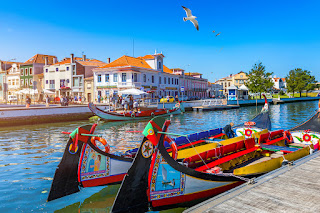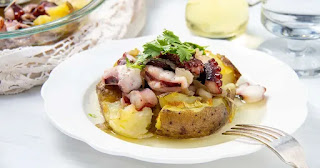Portugal, also known as the Land of the Seafarers, is the southwesternmost country in Europe. It has a population of about 10 million, most of whom are Catholic Christians. Portugal has a distinct and diverse culture derived from its long history. Portuguese people are known for their kindness and warmth. Well, there are several reasons why you might want to visit Portugal, including the affordable costs compared to other European countries, as well as the distinctive and diverse cultural and heritage structure, in addition to the picturesque nature and the beautiful and hospitable people.
1. What is the best time to visit Portugal?
Portugal is a beautiful country all year round, so the right time depends on you. If you love cities and the mild and pleasant weather, the spring and fall seasons can be beautiful. If you're a beach lover, summer may be for you, where you can visit beautiful beaches and enjoy the warm sun. If you are a fan of winter sports, the most suitable time for you is the winter season, where you can visit the Sierra da Estrela mountains.
2. What are the most popular tourist destinations in Portugal?
Portugal offers many options to visit and enjoy, including:
1. Lisbon
Portugal’s vibrant capital blends traditional charm with modern flair, featuring historic neighborhoods, trams, and the iconic Belém Tower.
2. Porto
Famous for its port wine, Porto enchants with its colorful riverside architecture and the Dom Luís I Bridge.
3. Sintra
A fairy-tale town nestled in the hills, known for its romantic palaces like Pena Palace and Moorish Castle.
4. Madeira
An island paradise nicknamed the “Island of Eternal Spring,” Madeira offers volcanic landscapes and scenic levada walks.
5. Azores
A remote archipelago in the Atlantic, rich in volcanic lakes, crater lakes, and lush greenery.
6. Algarve
Famous for golden beaches, dramatic cliffs, and charming coastal towns like Lagos and Albufeira.
7. Évora
A UNESCO World Heritage city filled with Roman ruins, whitewashed houses, and the eerie Chapel of Bones.
8. Coimbra
Home to one of the oldest universities in Europe, Coimbra is a city of learning, history, and youthful energy.
9. Óbidos
A medieval walled town with cobbled streets, colorful houses, and a majestic castle.
10. Douro Valley
A breathtaking region of terraced vineyards along the Douro River, producing world-class wines.
11. Cascais
A stylish coastal town near Lisbon, offering beaches, seafood, and a charming old town.
12. Aveiro
Known as the “Venice of Portugal” for its picturesque canals and colorful moliceiro boats.
13. Guimarães
The birthplace of Portugal, rich in medieval architecture and national heritage.
14. Serra da Estrela
Portugal’s highest mountain range, perfect for hiking, skiing, and scenic drives.
15. Nazaré
A traditional fishing village now famed for some of the world’s biggest surfable waves.
3. What are the most famous Portuguese foods ?
If you're thinking of trying Portuguese food, here are 10 popular Portuguese meals you should try:
1. Bacalhau à Brás
A classic dish made with shredded salted cod, onions, and thinly chopped fried potatoes bound with scrambled eggs.
2. Francesinha
A hearty sandwich from Porto layered with meats, covered in melted cheese, and topped with a spicy beer-based sauce.
3. Cozido à Portuguesa
A traditional boiled stew of meats, sausages, and vegetables a rustic, filling national favorite.
4. Caldo Verde
A comforting green soup made with kale (or collard greens), potatoes, and slices of chouriço (spicy sausage).
5. Arroz de Marisco
A rich seafood rice dish, similar to paella, loaded with shrimp, clams, mussels, and sometimes lobster.
6. Pastel de Nata
A creamy, flaky custard tart dusted with cinnamon, best enjoyed warm Portugal’s most iconic pastry.
7. Polvo à Lagareiro
Octopus roasted with olive oil, garlic, and potatoes, often served during festive occasions.
8. Sardinhas Assadas
Grilled sardines, usually eaten whole and served with bread or salad, especially popular in summer festivals.
9. Bifana
A marinated pork sandwich served in a crusty roll, often enjoyed with mustard and a cold beer.
10. Açorda à Alentejana
A rustic bread soup flavored with garlic, coriander, olive oil, and topped with a poached egg.
4. Portuguese culture
Roman Catholicism is the predominant religion, deeply influencing the country’s traditions, holidays, and family values, though modern society is increasingly secular. The official language is Portuguese, spoken with a distinctive European accent and used in all aspects of daily life, from education to government. Portuguese people typically enjoy a relaxed yet structured rhythm of life meals are social events, with lunch often being the main meal of the day, followed by a short break. The day often starts with a strong bica (espresso), and evenings are spent leisurely, often in cafés or public squares, reflecting a strong cultural emphasis on community and quality of life.
Portuguese traditional dress varies by region but is most often seen during festivals and cultural events. For example, in the Minho region, women wear colorful embroidered skirts and gold jewelry, while men don black trousers and vests. Although modern Portuguese fashion aligns with European trendselegant, modest, and seasonally appropriate locals tend to dress smartly, especially in urban areas. Traditional customs remain important, with festivals like São João in Porto and Santo António in Lisbon showcasing folk music, dance, and street celebrations. These events often include traditional food, costumes, and lively community gatherings that reflect Portugal’s deep respect for its heritage and regional identity.
Portugal is home to vibrant festivals that reflect its rich cultural heritage and love for celebration. Among the most famous is Festa de São João in Porto, a lively street party in June featuring fireworks, grilled sardines, music, and the quirky tradition of tapping people with plastic hammers. In Lisbon, the Festa de Santo António honors the city’s patron saint with parades, traditional folk dances, and neighborhood feasts. The Carnival season is also widely celebrated, especially in cities like Torres Vedras and Loulé, with colorful costumes, samba-inspired parades, and festive energy. Additionally, Fátima’s religious pilgrimages attract thousands of worshippers each year, blending spiritual devotion with national pride.
5. Accommodation and costs in Portugal .
Portugal offers a wide range of accommodations to suit every traveler’s style and budget, from luxurious resorts to cozy guesthouses. In major cities like Lisbon and Porto, tourists can find elegant boutique hotels and modern serviced apartments in central, walkable locations. Along the Algarve coast, beachfront resorts and family-friendly hotels provide stunning ocean views and premium amenities. For a more local experience, charming guesthouses (alojamentos locais) and traditional quintas (country estates) offer warm hospitality and authentic Portuguese ambiance, especially in rural areas and wine regions like the Douro Valley. Whether staying in a five-star hotel or a rustic cottage, visitors can expect comfort, cleanliness, and friendly service throughout the country.
Portugal is considered one of the most affordable destinations in Western Europe, offering excellent value for travelers. Accommodation, food, and transport are generally budget-friendly, with quality meals available at local restaurants for as little as €10–15. Public transportation is efficient and inexpensive, especially in cities like Lisbon and Porto where metro and tram systems are widely used. Entrance fees to museums, historical sites, and attractions are usually modest, and many natural sights like beaches, parks, and viewpoints are free to enjoy. While luxury options exist, Portugal caters well to budget-conscious tourists without compromising on experience or comfort.
Finally, Portugal is a truly special destination that captivates tourists with its stunning diversity, rich history, and warm, welcoming culture. From golden beaches in the Algarve and dramatic cliffs along the Atlantic coast to the fairytale palaces of Sintra and the vineyard-lined hills of the Douro Valley, the scenery is breathtakingly varied. The country blends old-world charm with modern energy where ancient castles, cobbled streets, and UNESCO World Heritage sites meet lively festivals, buzzing cities, and world-class cuisine. Add to that a mild climate year-round, affordable travel costs, and the genuine hospitality of the Portuguese people, and it’s easy to see why Portugal continues to enchant travelers from around the globe.






























